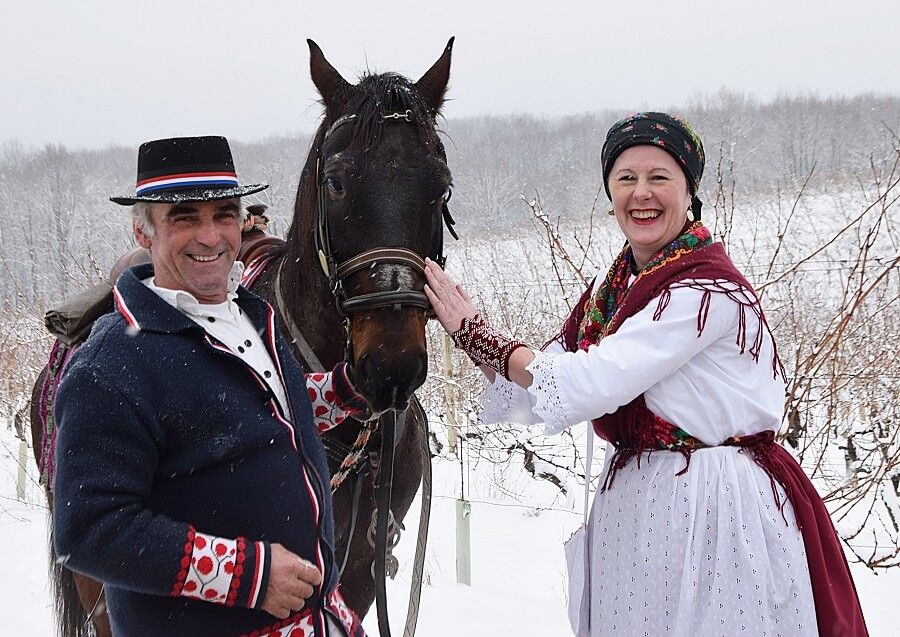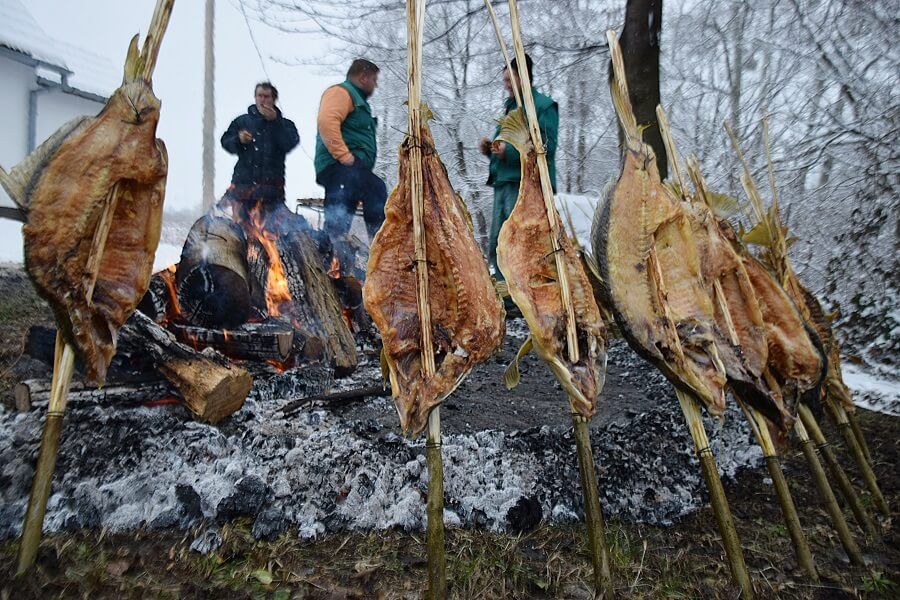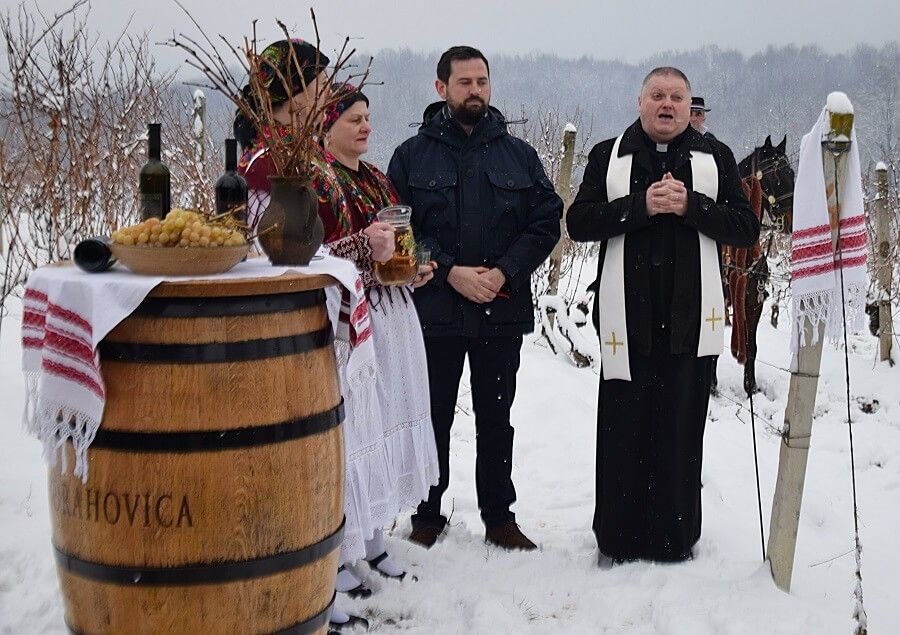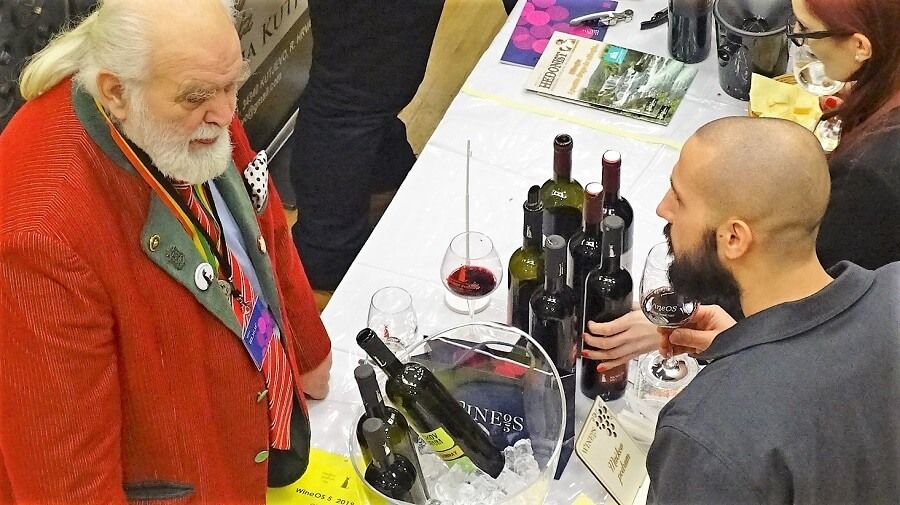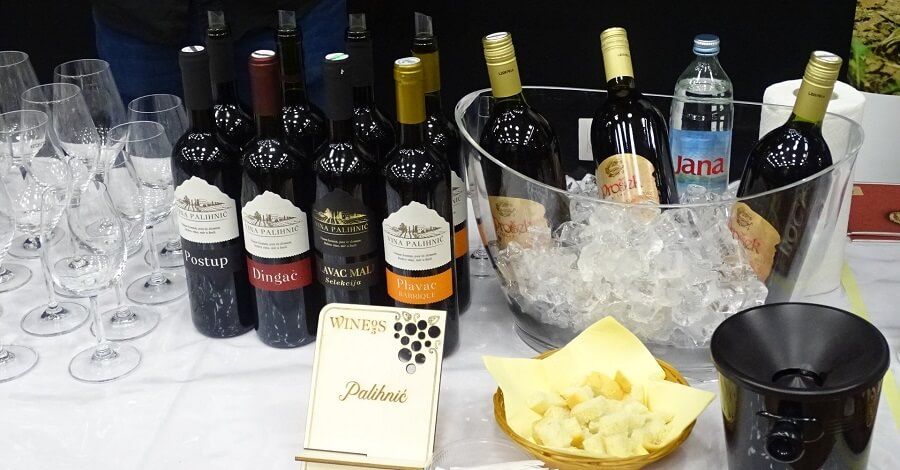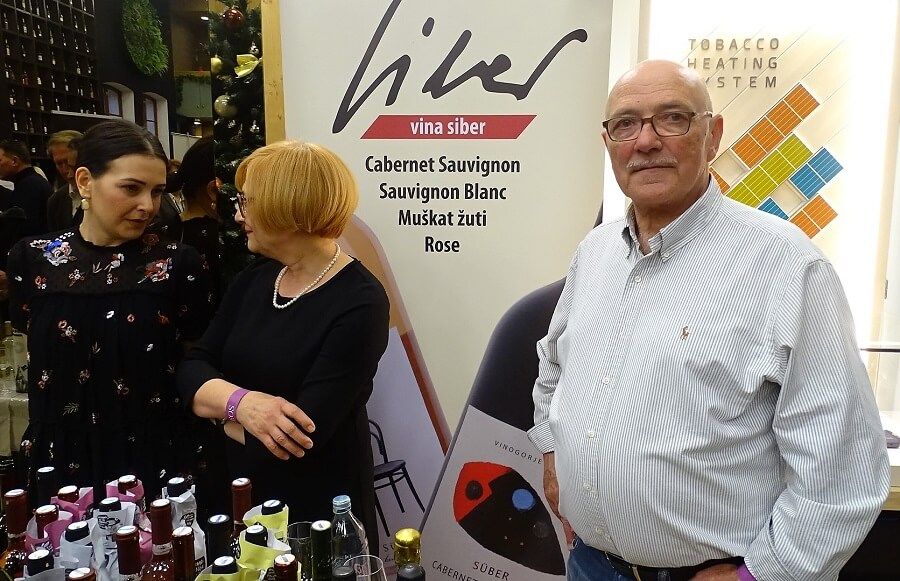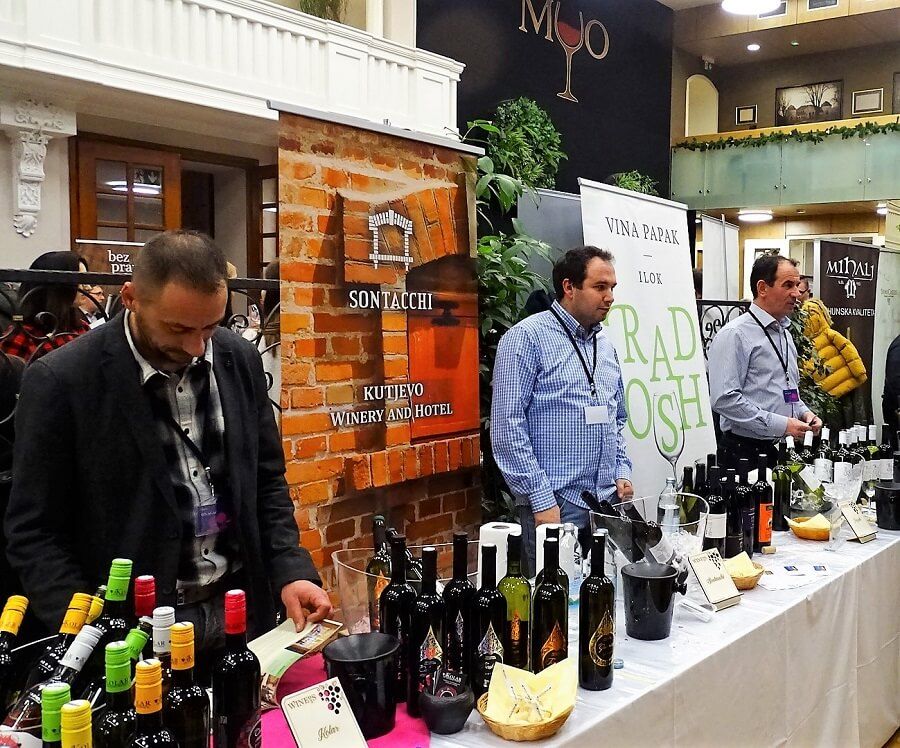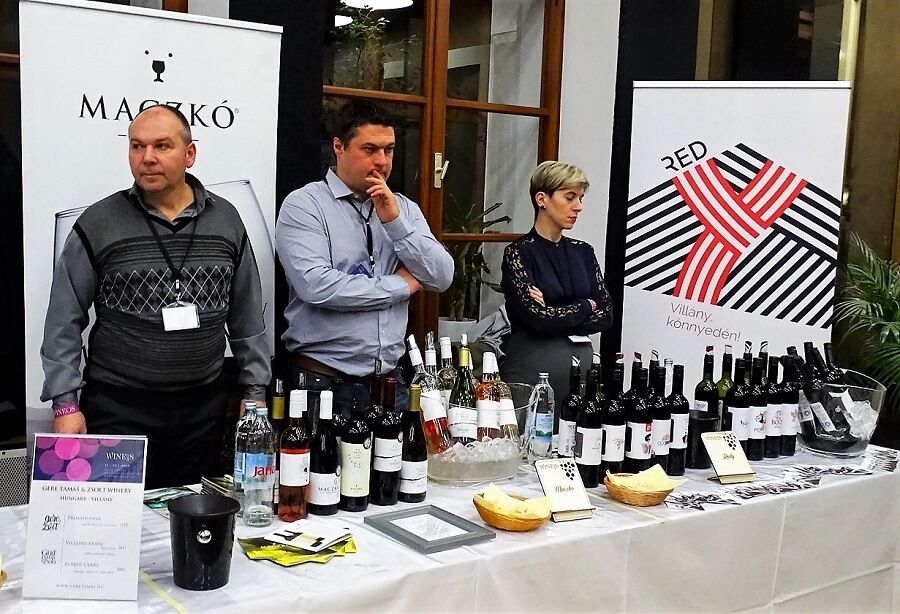Chinese Businesswoman Launches Slavonian-Dalmatian Winemaking Project
A visit to the En Primeur young wine festival, held on January 31 at the Westin Zagreb Hotel, was an excellent opportunity to taste young wines and get acquainted with the latest developments on the Croatian wine scene. The event was dominated by Slavonian winemakers gathered by the Graševina Croatica association, and it also brought together winemakers from Međimurje and Dalmatia. I was pleasantly surprised by the news that a businesswoman from China has bought a vineyard in Kutjevo and launched her own Slavonian-Dalmatian winemaking project.
Qin Hellner was born in Beijing and has a degree in international business from Shanghai Maritime University. For about a decade, she worked for COSCO – the largest Chinese state-owned shipping company. In the mid-1990s, she moved to Melbourne where she ran a private brokerage firm.
With her former husband, a German, she decided to move to Europe in 2012 to provide their children with European education. Her son was enrolled at a German boarding school, but Germany was not the place where Qin wanted to live. They were looking for a pleasant place to live, and in Melbourne, she met the Croatian Consul General Antun Babić, who told her about how Croatia is a great country for a living.
Without much thought, she accepted the consul's invitation and visited Croatia. Since Mr Babić is a Slavonian, they first visited Kutjevo and the Golden Valley, met the famous winemakers Vlado Krauthaker and Ivo Enjingi, and then went to the Croatian coast.
“Although the visit was short, we immediately fell in love with Croatia and decided to stay here. We moved to Zagreb and decided to invest in a business in Croatia, but we soon realised that it was not easy to do it because of all the bureaucratic complications in Croatia. Of course, we did not give up, and we soon bought a vineyard in Kutjevo because we were impressed by the people we met there during our first visit to Croatia, with their culture and hospitality. We fell in love with the Goldey Valley landscapes that reminded us of the 150-hectare farm we owned in Australia.”
Initially, she did not intend to produce her wine but primarily enjoy the rural landscapes. They sold their grapes to others to financially cover the upkeep of their vineyard and make a small profit.
After the divorce from her husband, Qin could choose between the vineyard in Kutjevo and the yacht, and she naturally opted for the vineyard. Last year, due to the abundant grape harvest in the Golden Valley, she could not find buyers for her grapes. She turned a problem into an opportunity and decided to produce her wine, helped by winemaker Antun Plančić from Hvar. She was introduced to Plančić by a business partner with whom she is building a tourist complex near Zagvozd. “If everything turns out fine, we will offer packages to our guests in Zagvozd which will include a visit to the Golden Valley and our vineyard, which also includes a holiday home. Of course, we will also offer boat trips to the Dalmatian islands, especially to the Plančić winery on Hvar where our wines are finalised.”
The vineyard covers two hectares, and Graševina covers 80% of it. Qin's focus is on quality, and she plans to produce between 10,000 and 12,000 litres of wine annually.
“Since my main job was international trade, I used to travel a lot. I am now in active retirement, so I have enough time to travel for fun. If I notice a good business project, then my trip is more than just having a good time. My lifestyle is no longer as intense as it used to be, but it is very relaxing. My biggest passion is food and these days I travel to enjoy different cultures and their gastronomy. "
Qin says Croatia is a beautiful country with wonderful people, full of energy and entertainment, but it is complicated to follow Croatian legal and regulatory frameworks. "That is why I do not want to go into too large investments here. And if by any chance I do not succeed in business ventures here, at least I will own great properties and have good wine to enjoy with my friends. That is enough for me! "
Given the positive energy she radiates, I believe that Qin will succeed in spite of all the administrative obstacles faced by investors in Croatia. Her example will be a pointer to others who can see that tourism potential in Croatia is not limited just to the Adriatic coast.
More news on Croatian wines can be found in the Lifestyle section.
En Primeur Wine Event Held in Zagreb
On Thursday, the Graševina Croatica, Wines of Dalmatia and Hortus Croatiae associations, together with the Croatian Chamber of Commerce (HGK), once again hosted the popular wine event En Primeur, which brought together more than 60 winemakers who presented Graševina, Pošip, Pušipel and other Croatian autochthonous varieties from three wines regions: Slavonia and the Danube region, Dalmatia and Međimurje.
This increasingly popular and essential wine event was held at the Crystal Hall of the Westin Hotel in Zagreb and has again confirmed its excellent reputation, with guests, professionals and citizens happy to take part and the number of exhibitors and visitors growing. It is a unique opportunity to taste young white wines from the latest harvest, as well as red wines from previous years.
Croatian wines are becoming more recognisable on the European and world markets, as evidenced by numerous awards that Croatian wineries win with their wines year after year. Representatives of wine regions and established winemakers looked back at the 2018 harvest and shared their experiences.
Vlado Krauthaker, the president of Graševina Croatica association, commented on the last year. “The 2018 harvest in Slavonia, as far as the yield is concerned, was a bit better than the previous one. We have decided to present the results here at En Primeur, so everyone was invited – sommeliers, restaurant owners and managers, bars, hotels, F&B managers, distributors and other professionals. They can see how we as winemakers experienced last year. They have witnessed the quality of the wines and could see for themselves the differences in these three different regions. Given the excellent grape quality we had during the harvest, I think the market can expect truly extraordinary wines,” said Krauthaker.

President of the Hortus Croatiae association, David Štampar, summed up the year in Međimurje. “The last year was one of the more difficult winegrowing years, which started very late with vegetation. There was a lot of rainfall, but the rains were nicely spread, so the harvest still gave us good and healthy grapes. Due to more rainfall and colder nights starting from the second half of August and not too early harvest, we again have the result that we have almost every year in the Međimurje wine area: fresh wines with lighter to medium alcohol, and with expressed fruity. These wines are easy to understand, but they are no less attractive.”
The year in Dalmatia was summed up by Ivica Kovačević, the president of the Wines of Dalmatia association. “It was another special wine-growing year that was defined by ideal rainfall during the vegetation period and optimal temperatures that favoured the ripening of grapes. This was one of those harvests that are characterised by good yields and excellent grape quality. As the Dalmatian area is heterogeneous, joined with the excellent work of wine growers and the expertise of our oenologists – we can expect fresh and light white wines, but also more powerful Pošips. We believe that the year 2018 will become known as exceptional and one of those that are especially remembered by the wine community. Plavac Mali should be particularly remembered for the 2018 harvest, but for confirmation, we still have to wait for several years.”
HGK’s Vice-President of Agriculture and Tourism Dragan Kovačević said, “We expect a lot from last year's harvest. First of all, with regards to the quality of the wine, but also to exports, as well as to the pleasure for palates of locals and tourists. It is encouraging that wine exports grew by more than 22 per cent in the first ten months of last year, particularly in the segment of quality and top-quality bottled wines and sparkling wines, i.e. more expensive products. This is proof that we are beginning to be increasingly respected beyond the borders of Croatia.” He added that he believed that the new Wine Act would provide a new impetus to the development of winemaking, particularly of top-quality wines with a geographical origin, where wine producers and regional producers' associations will play a key role in winemaking and branding.
More news on the Croatian wines can be found in the Lifestyle section.
2019 Vincelovo at PP Orahovica
Jezerac – the picturesque vineyard which has been giving us the finest grapes for years and which the renowned oenologist Ivana Nemet magically turns with a lot of gentleness into top quality wines that win numerous awards throughout Croatia and the world – was the venue for this years’ celebration of Vincelovo at PP Orahovica, which is always marked there on January 22nd, on the feast of St. Vinko. The specific location offers beautiful views of the nearby Slavonian hills, which were specially dressed in beautiful snowy watercolours for this year’s festival.
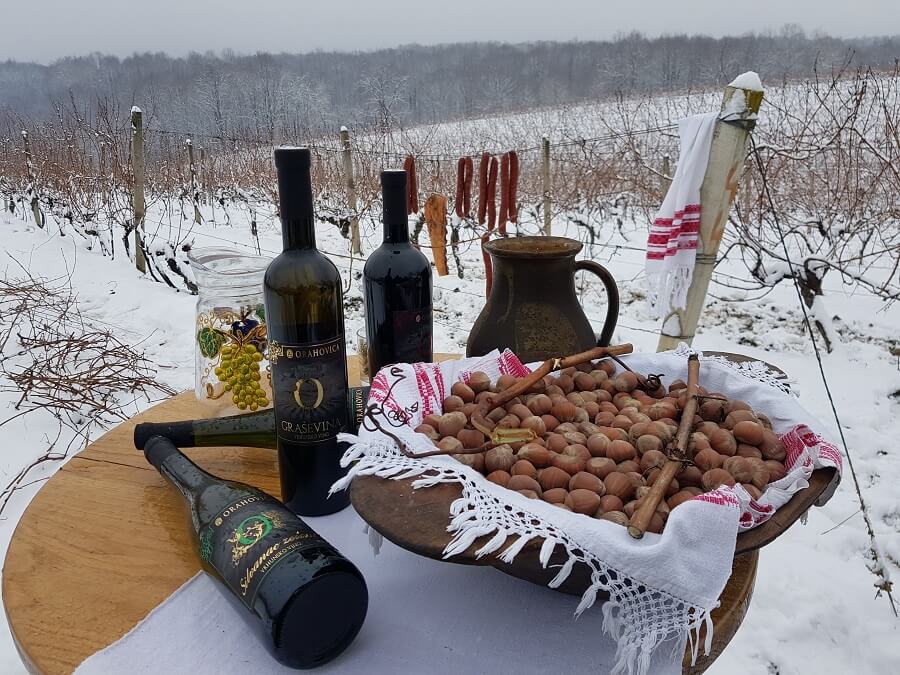
And just like in ancient times, the tamburitza players could be heard from the vineyards, these eternal friends of the wine, the winemakers and lovers of the drops of wine in which there is the truth. On Vincelovo, people send prayers to St. Vinko to have a good harvest in vineyards. Afterwards, the wine boss, in this case, Josip Tokić, the head of Department of Fruits and Vineyards, cut the first vine in the vineyard, which was decorated with bacon and sausages and christened with the wine.
The 4.5 hectares of Jezerac produce the best Zeleni Silvanac, the variety that is the pride of the Orahovica area. In addition to Zeleni Silvanac, prizes are regularly won by the Jezerac excellent wine.
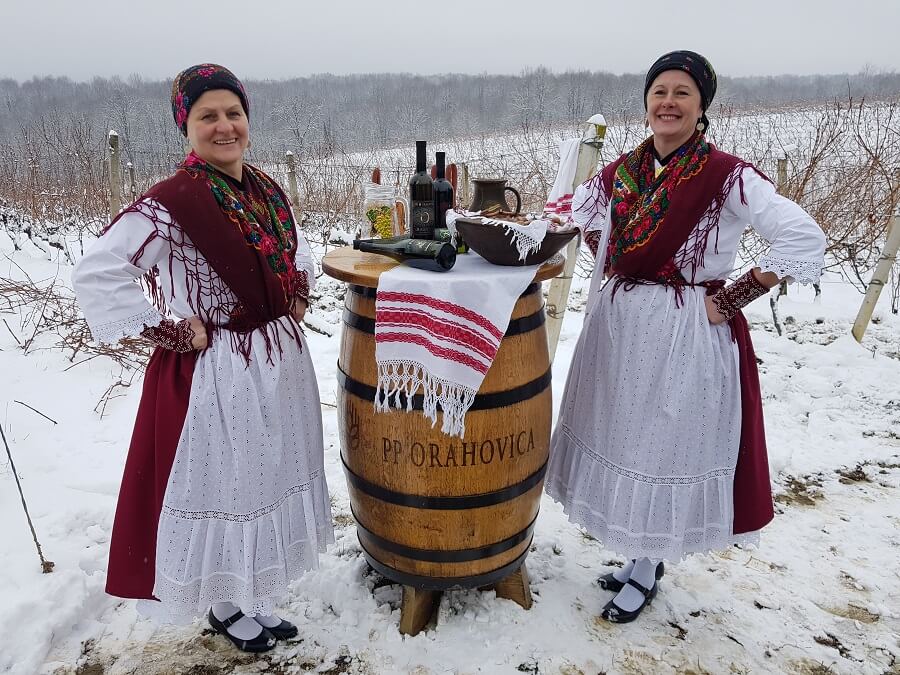
As is usually the case at Vincelovo, the smell of roasted bacon and homemade sausages could be felt far and wide, with grill masters also preparing carp on the rake just nearby. The fish was from the company’s ponds at Grudnjak, a pond near Orahovica which covers 950 hectares. PP Orahovica is the largest producer of freshwater fish in Croatia, and according to experts, for the grilling on the rake, the best ones are those weighing between two and three kilograms. In addition to fish farming, PP Orahovica is the leading producer of hazelnuts in the region.
“Let there be snow and freezing weather when it is needed, and rain and sun when the vines need them," said in his blessing Željko Strnak, the local priest.
“Last year, we had an excellent harvest and great sales results. Our wish for St. Vinko is for that to be repeated this year. PP Orahovica bases its wine production on 180 hectares, with 100 hectares of vineyards in full growth, and 80 hectares of young plants which are recovering,” said Tokić, pointing out that they annually offer to the market between 700,000 to 800,000 litres of wine.
It is commendable that they delivered around 100,000 litres annually to the demanding markets of China, Japan, Mexico, the Netherlands and other countries. “We are working on exports of Frankovka and Graševina to Japan and the Netherlands. Some of Graševina going to the Netherlands will end up on exotic Caribbean islands of Curacao and Bonaire,” said Igor Hruškar from PP Orahovica’s marketing department.
As it is proper for Vincelovo, the party continued deep into the night. For everything to turn up as it should and for St. Vinko to listen to our prayers, we all need to drink a bit and kiss a lot.
More news on Croatia’s wines can be found in the Lifestyle section.
Kutjevo Celebrates Vincelovo 2019
There is just one St. Vinko, but a lot of Vincelovos! Nevertheless, the largest and the best-known celebration of the feast of the famous saint in the Požega’s Golden Valley is traditionally organised by Kutjevo.
The picturesque Vinkomir vineyard hill, high above the town of Kutjevo, suddenly becomes alive and awakens all the good spirits of the magic of taste and smell of high-quality young and mulled wines. And not just wines, but of everything which Slavonia has to offer. Local and international guests could also try to grill and taste the Slavonian sausages, enjoy the deliciously roasted carp halves, enjoy the lamb and ox meat on a spit and some homemade cakes. Immediately after the arrival, the guests were presented with glasses in order not to "suffer" while sausages were grilled and for the whole experience to be complete because that is precisely what hedonists really love. Helped by the musical programme presented by cultural societies Bektež from Bektež and Poljadija from Grabarje, the Slavonian atmosphere was guaranteed!
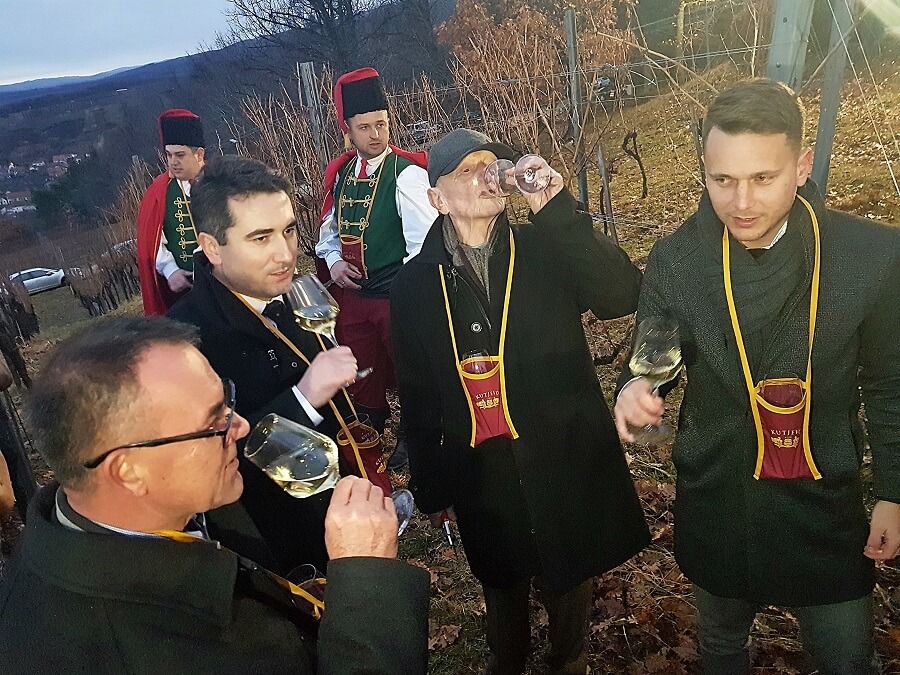
From the beginning of times, people always needed to prune their vines and bless their vineyards, and then to drink good wine in order to make the vineyards produce a lot of grapes that year. It appears that last year's prayers to St. Vinko were very much heard since sales records have been broken.
As in previous years, Enver Moralić, the majority owner of Kutjevo, was joined at this festive event by former president Stjepan Mesić, as well as Alojz Tomašević, the prefect of Požega-Slavonia County; Josip Budimir, the mayor of Kutjevo; Josip Ređo, the CEO of Kutjevo. Kutjevo parish priest Marijan Đukić blessed the event.
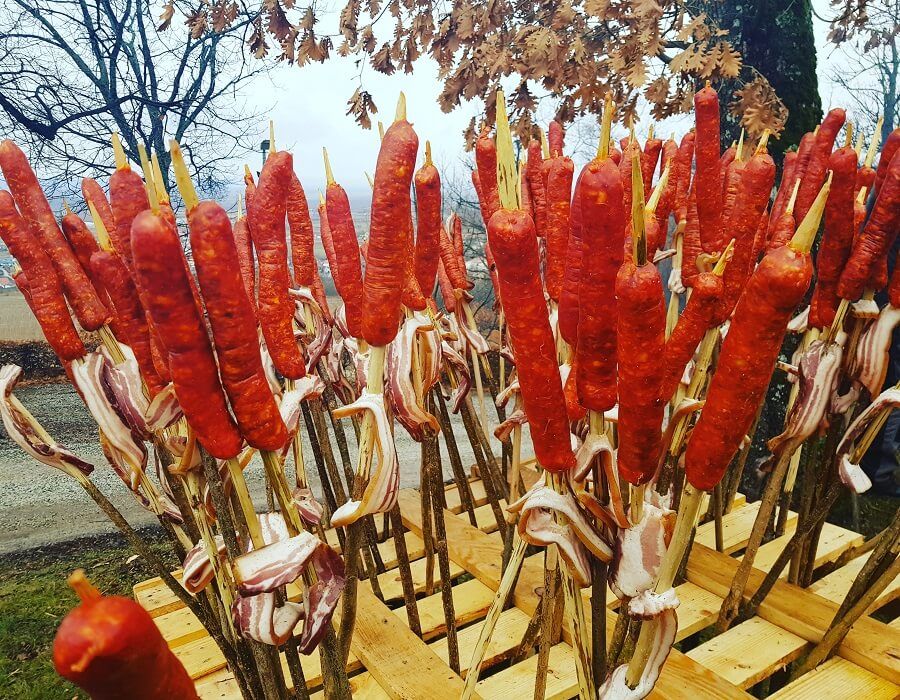
"This past year was filled with many medals won at both domestic and foreign wine competitions, and we sold the record five million litres,” said Ređo at the start of the event in a specially constructed VIP tent.
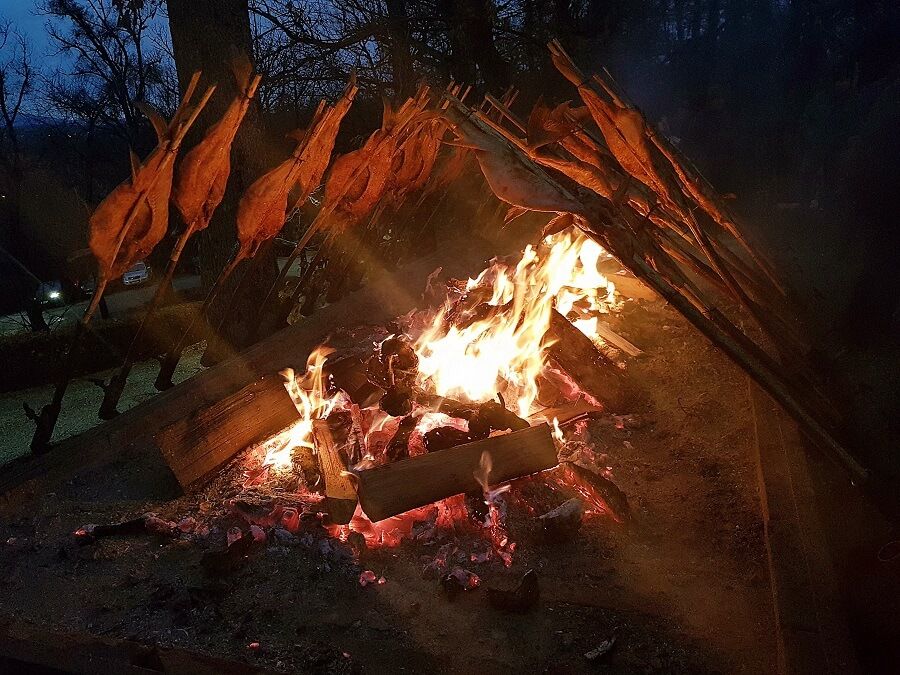
Of course, this year's Vincelovo was an excellent opportunity for the famous winemaking giant to thank all the friends and business partners for their loyalty, as well as journalists from all over Croatia who have been following the company for years and have faithfully reported on all of its impressive achievements.
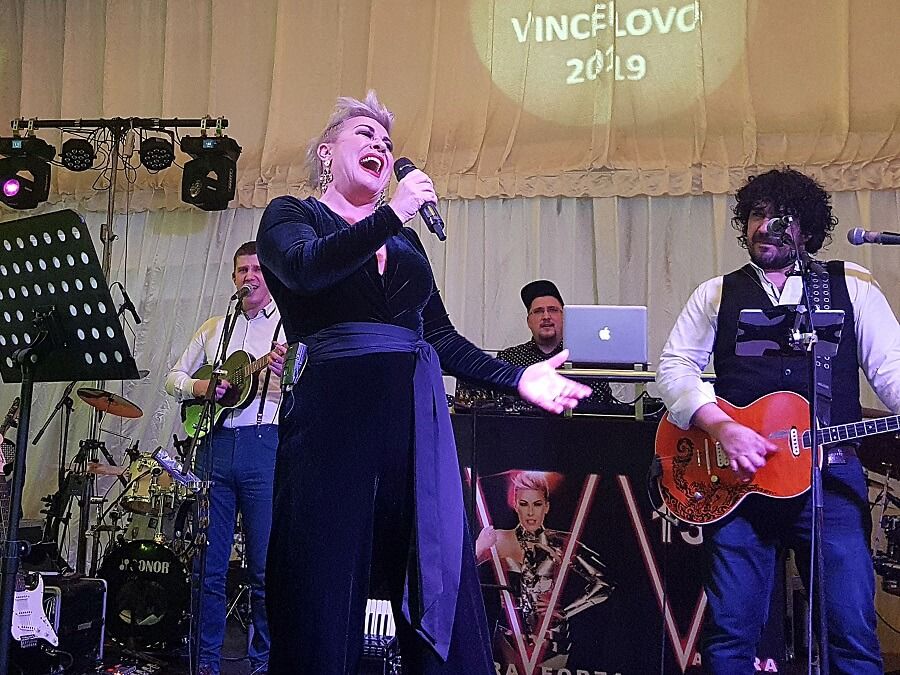
More than 700 guests enjoyed the Slavonian specialities and the young wine, with the festive atmosphere being provided by joyful Indira Forza (who did not forget to praise the juicy sausages), and the Dyaco tamburitza band. The true Slavonian feast lasted until the early morning hours, with people enjoying the wines, dancing and listening to tamburitza music. As always at the Vinkomir, people wined and enjoyed themselves throughout the night.
More news on the Croatian wines can be found in the Lifestyle section.
Croatian Winemakers Present their Wines at Berlin's Green Week Fair
ZAGREB, January 20, 2019 (Hina) - Croatian winemakers are presenting their products at the 84th International Green Week fair in Berlin, which is taking place from January 18 to 27.
Thirteen Croatian companies are exhibiting their products with the support of the Croatian Chamber of Commerce (HGK) and the Ministry of Agriculture.
"Half a million visitors and a turnover of nearly 50 million euros generated through direct sales at the fair show that International Green Week is one of the most important events for the agricultural sector. This is an exceptional opportunity for Croatian producers to present their quality and expand to new export markets," HGK president Luka Burilović said at the opening ceremony.
With the aim of branding Croatia as a wine country, the HGK organised a promotional evening on Saturday to present Croatian wines to highly-regarded Berlin restaurant owners.
In 2017, Croatia exported 786 tonnes of wine worth over 2 million euros, while in the first nine months of 2018 exports exceeded 700 tonnes to reach the value of 1.9 million euros, the HGK said.
Croatia will be the partner country of next year's Green Week.
More news on the Croatian wines can be found in the Lifestyle section.
WineOs Festival in Osijek Exceeds Expectations
The fifth WineOs wine festival exceeded all expectations, which were quite high after the previous four successful WineOs editions. I have attended WineOs since the very beginning, since 2014 when the first edition was held at the premises of the Museum of Slavonia. In the very first year, WineOs immediately became the central wine event of eastern Croatia. Of course, events such as the Evenings of Wine and Art, which are held twice a year at the courtyard of the Kazamat gallery, must not be forgotten, but that is an event that brings together local winemakers, while WineOs, in addition to the locals, also brings in winemakers from the rest of Croatia as well as from abroad, making WineOs qualitatively and conceptually equal to the Zagreb wine events such as VINOcom. The only exception is the number of exhibitors, but the quantity and quality do not necessarily go hand in hand.
Wine is a specific product, and even to highly-experienced tasters, it is difficult to taste many different wines in a relatively short time frame. Therefore, when I attend wine festivals, I am always somewhat disappointed that I will not be able to taste most of what is offered. Wine should be enjoyed, both organoleptically and in its flavours, and the goal is definitely not to get drunk. Therefore, I am glad when I am not faced with a sea of exhibitors at one location. In case of the festivals with a large number of exhibitors, I always advise the organisers to make the event last longer for a day or two so that visitors can accurately absorb and valorise all that is offered and seems intriguing to them.
After two editions at the Museum of Slavonia, in the old town centre – Tvrđa, the WineOs moved for two years to the modern building of the Esseker Centre at Ribarska street in Osijek. It is an excellent location which connects the Osijek main square with the pedestrian zone along the Drava river promenade. The Esseker Centre itself is exceptionally functional and spacious but for my taste maybe a bit too modern. The best environment for wine festivals are venues with a tradition and a story to tell... The old saying is "the older wine is the better wine”, and that could be applied to the wine festival venues as well.
The fifth WineOs was held at the Muzej Okusa (Museum of Taste) restaurant, in the former City Garden pavilion. It is a protected cultural site built in 1804, thoroughly renovated in 2016. This is the location where, 210 years ago, Osijek was proclaimed a free royal city.
In the central room of the Muzej Okusa, the exhibitors were divided into eight separate areas. The first exhibition stand to the right of the entrance was occupied by the Grafika company from Osijek. There is no quality branding and good marketing of wine without proper visual design solutions, so Grafika presented a whole range of different labels for wine bottles.
Per my personal habits, I always taste the wines in a defined order, starting with white varieties, followed by the rose and red varieties. This time I made an exception; when I saw Domagoj Buhač, one of the best Ilok winemakers, having previously heard that he had recently bottled his last year's rose, I just could not resist. I had to taste it, skipping the usual schedule. And why did I choose the Buhač rose? This wine has a sentimental value for me because it is the first wine my wife tried without saying that it was sour, bitter or merely unsavoury. A few years ago, I took her to WineOs to break her mental opposition to wines. I have to admit, it was not easy! I advised her to taste different types of sweet wines, late and elective harvests. By the expression on her face I realised that she was not really thrilled; after a modest and cautious sip, most of the content of the glasses would later end in a pouring bowl. And then, when I was starting to lose hope that I could ever turn her into a wine fan, we came to Domagoj who poured her a glass of his rose wine. By the expression on her face, I saw that was it! I finally succeeded in my mission to make her fall in love with wines. The fact that it was just one label from one producer did not mean much. Domagoj warned me that last year's vintage was somewhat sweeter than the previous ones, but I did not see that as something negative, on the contrary. I am only sorry that I will be in the Netherlands at the time of Vinkovo this year, so I was not able to accept Buhač's invitation to join his party. I will also have to skip the usual Vinceška warm-up event at Banovo Brdo in Baranja. But well, there will be more Vinkovos, Vincelovos and Vinceškas. In addition to the Buhač winery, the Ilok vineyards were represented by wineries TRS, Papak, and Iločki Podrumi.
Immediately at the entrance to the festival, I was intrigued by two excellent wineries from Vojvodina, whose wines I regularly enjoy. They are the Erdevik winery from Erdevik in the Srijem region, located just south of Ilok, and the Zvonko Bogdan winery from Palić in the Bačka region. As for the wine hits of the latter winery, I must highlight Osam Tamburaša, a unique white coupage consisting of Sauvignon Blanc, Chardonnay, Pinot Blanc and Muscat, in the 50:25:20:5 ratio. Later, I could not resist to taste the black coupage Život Teče (Merlot / Cabernet Franc / Frankovka). The Erdevik winery offers a great chardonnay called Omnibus Lector. They also have pink wines Rosa Nostra (90% Merlot, 10% Cabernet Sauvignon) and Tri Roze Koze (50% Merlot, 30% Syrah, 20% Cabernet Sauvignon). Another exceptional wine is their black coupage Trianon that consists of 55% Merlot, 37% Syrah and 8% Cabernet Sauvignon.
The Krauthaker winery, as the best winery of the Kutjevo wine region, pleasantly surprised us with a large number of offered labels. One of their unique features, which makes them different from the competition, is that they separately bottle their Graševine wines from each separate location. Of all the wines offered, I was particularly impressed by their Silvanac Zeleni. The festival was also attended by the Sontacchi boutique winery from Kutjevo, which used to draw a lot of media attention with their “male virility” wine – Kitokret. In the meantime, they have begun to develop a serious wine and tourism initiative under the slogan "The Grape Escape".
The festival open to the public at 3 pm and the opening ceremony was scheduled for 4.30 pm. Just half an hour after the opening, queues were forming at some stands, which demonstrated the substantial interest of visitors and the fact that are many fans of wines in Osijek and Slavonia. But, someone needed to create this fan base, and most credit for this definitely goes to the Vinita wine-shop, which has held presentations of winemakers and their wines for years, with a symbolic 50 kuna entrance fee, which is also a voucher to buy the wines.
An essential role in the initiative to make Osijek-Baranja County perceived as a wine-growing region, and not just as an area characterized by endless fields of corn, also belongs to the Wine Tour project, which helped organise a dozen wine roads and establish wine museums in each of the four wine areas of Osijek-Baranja County, as well as the central wine cellar in the Osijek's historic town centre - Tvrđa. To be honest, of these four museums the only one which is genuinely operational in the one in Zmajevac in Baranja, primarily thanks to the members of the Surduk Hungarian traditions association, but that is a topic for a different article. What is positive is that Osijek is now finally perceived as the centre of a wine rectangle, with Baranja wine area on the northern tip, Erdut on the eastern, Feričanci on the western, and Đakovo on the southern tip.
As for the Baranja wine area’s representation at WineOs, it included Svijetli Dvori from Karanac, wineries Pinkert and Kolar from Suza, Kalazić and Josić from Zmajevac, and the wine giant Belje. The Kolar winery successfully combines winemaking and tourism and owns the Suza Baranje mini-camp which, along with three more camps from the Slavonia region will be presented at the Caravana camping fair to be held from 17 to 23 January in Leeuwarden, Netherlands.
The Erdut wine area is geographically the closest to Osijek, and the Erdutski Vinogradi is the cornerstone of the winemaking in this area. Under its patronage and thanks to Hrvoje Pavić, a collection of papers from the scientific conference “Wine and Wine-Growing in the History of Slavonia, Srijem and Baranja” is about to be published. When it comes to Erdut, one must mention the Brzica winery. I was most impressed by its Chardonnay. The winery is located at perhaps the most visually appealing part of the Erdut wine area, on a Danube meander that offers excellent views. It was a pleasure to listen to Borna Brzica, one of the sons of the winery owner Ivo Brzica, talking about plans for a glamping resort. We should also mention the Süber winery, which recently launched the flavoured sweet Sibernet wine and changed the graphic design of its products. Feravino represented the Feričanci wine area and Misna Vina from Trnava the Đakovo wine area.
The festival featured winemakers from neighbouring Hungary, from their winemaking centre Villány – Maczko, Gere Tamas & Zsolt and Bock. Of the winemakers from Bosnia and Herzegovina, the most prominent was the Povratak iz Žepča winery with its unusual wines, such as the one made from the Czech variety Palava.
All those who had too much wine could make a radical break and enjoy the beers of the von Becker craft beer brewery from Osijek. Brewer Bojan Pap personally served the beer from his workshop. In addition to the beer, you could have a glass of the Jedan (One) brandy. Well, more than one, perhaps.
A particular highlight of the first day of the festival was the workshop called Croatian Wine Treasures of Hrnjevac Wine Genius, presented by wine writer Željko Garmaz, which offered a tasting of a whole range of archival wines by Ivan Enjingi. The legendary winemaker immediately emphasised that he is trying to produce the healthiest wines possible, just like they were made 100 and more years ago. “Industrial wines will ruin the mankind,” said Ivo. After the attendees tasted his fantastic wines, they simply had to agree with him.
In the end, we should praise those without whom this great event would not be possible: Vinko Ručević, who came up with the initial idea, and president of the organisational committee Boris Ocić. Given the development of the event so far, there is no doubt that the next, sixth WineOs, will be even more interesting, splendid and exciting.
More news on the Croatian wines can be found in our Lifestyle section.
Coral Griffin, Sparkling Wine from the Adriatic Sea with Unique Label Created by Nature
There is no better moment for the promotion of a new sparkling wine than near the end of the year when even those who are not fans of bubbles often ignorantly shake their bottles, launching the cork among the guests and wishing everyone all the best. Of course, to do even something remotely similar did not even occur to Krešimir Ivančić, the experienced and inspired, talented and successful winemaker from Plešivica. Naturally, everything began in the vineyards, scattered on the sunny slopes of Plešivica, where ten years ago with a lot of passion Ivančić decided to take advantage of the potentials of terroir and varieties and produce sparkling wines with distinct variety characteristics. The Ivančić winery currently has nine labels, including five sparkling wines, three white wines and one red wine. It produces about 25,000 bottles a year and distributes it all in restaurants, wine-shops and at the doorstep, and there is even a waiting list for some labels from this year's harvest!
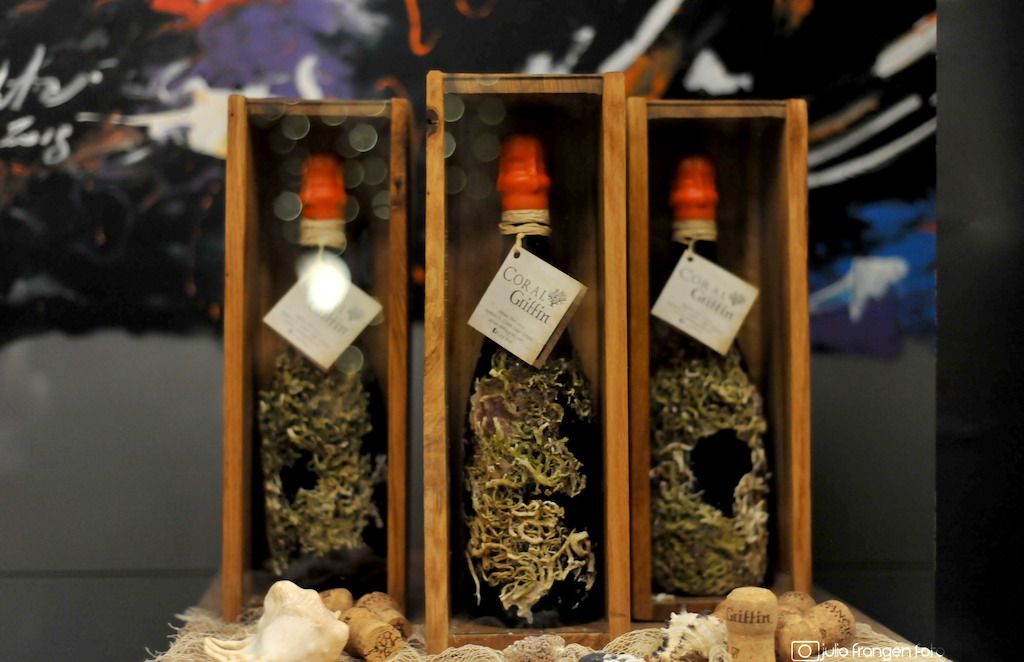
When selecting the label name, Krešimir did not keep to the usual tradition of choosing the name by the producer's surname, but instead chose a mythical being – a griffin – a beast with the body of a lion and the head of an eagle, which is also on the coat of arms of the Ivančić knightly family. Aeschylus called him Zeus’s dog with a bird's beak and no bark, and according to Greek mythology, the griffin protects the entrance to the wine cloister of the god Dionysus – at the Ivančić winery, he is protecting bubbles of his sparkling wines!
The unique characteristic of these vineyards is that most of them are located on slopes with over 2,000 hours of sunshine per year, which is almost a fifth more than the average in inland Croatia, and the highest is at 400 metres above sea level. The vineyards are cultivated manually because the locations are very steep, and in one vineyard you cannot even enter without special shoes.

The first Griffin Brut series was produced in 2013, and it is the first sparkling wine with the mark of top-quality wine produced from the Müller Thurgau variety (Rizvanac). From another neglected variety – Portugizer – almost out of spite – Ivančić has produced two more top sparkling wines – Griffin Dark Side and Griffin Rosé, who have won gold medals at the Portugizer du Monde world competition several years in a row, confirming that the Portugizer can also produce great sparkling wines. Griffin Dark Side has thrilled Spanish media with its elegance and complexity, and manager of the prestigious Akatavino magazine awarded it 92 points and categorised it as an unexpected surprise. In addition to the prize from the Portugieser Du Monde competition in Pecs in Hungary, Griffin Brut became the champagne champion at the Russian wine rating competition called Black Sea Forum, while Griffin Zero and Griffin Dark Side won gold medals.
How much effort he has invested in his wines and his personal education is demonstrated by the fact that he is the only Croatian winemaker who has been for many years a judge at international exhibitions and reviews of wines such as Awc Vienna, Mundus Vini and the Russian rating of wines from the Black Sea countries. This is not surprising for anyone who knows Ivančić: he is serious in everything he does (in addition to learning a lot about wines and becoming a winemaker in ten years, the 2-metre-high guy from Plešivica is an excellent angler and since recently a licensed diver), he also carefully studies and experiments with various vinification methods, and he was ready to accept the help of the oenologist Goran Marmilić in order to find a way to keep the variety characteristics in the smell and the taste one variety wines, with no blending.
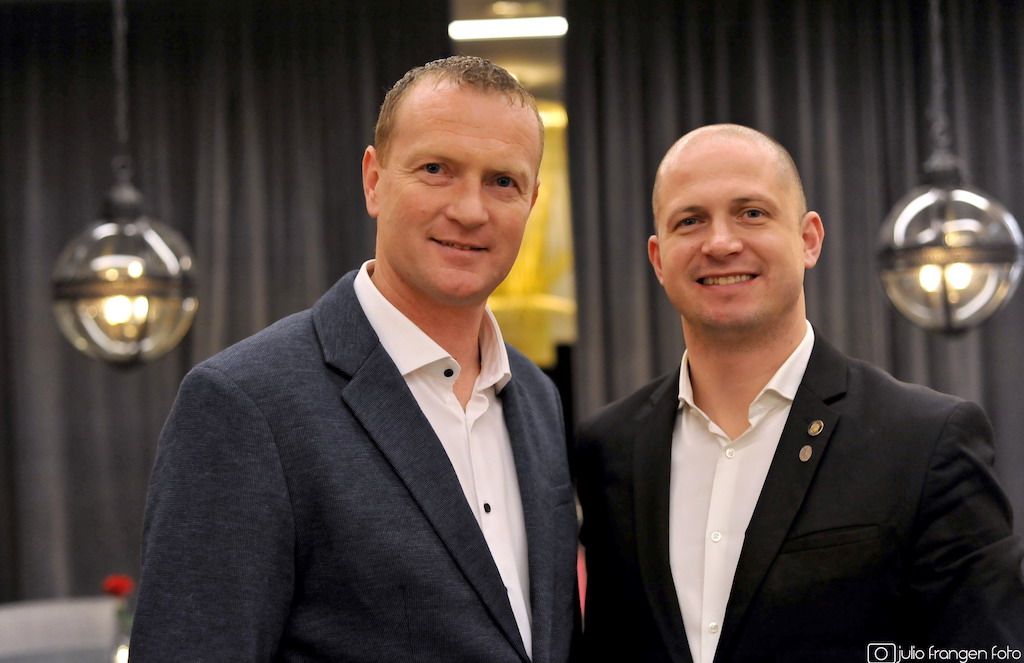
The combination of knowledge, youth and unique terroirs at the highest Plešivica positions has brought the liveliness into a somewhat dormant Croatian wine scene and made great strides in the popularisation of sparkling wines. We are especially pleased with the fact that more and more young winemakers are starting to research new things in an effort to push their ideas into their bottles. After all, one thing is clear – Ivančić is a fascinating "guy", a man who has abandoned his engineering career and turned to the wine business where he obviously “swims” very successfully.
Interestingly, until recently his sparkling wines also swam in the water – literally. The label in question is Coral Griffin, the latest sparkling wines of unique scents and flavours that replaced the Plešivica hills with the unique conditions of the sea depths. As soon as you take a look at a bottle covered with sea corals and algae, secured in a handmade solid wood box with a glass window, it is clear that this is a unique sparkling wine worth enjoying more than just for the New Year's Eve or other celebrations.

The project of resting the sparkling wines at the bottom of the sea, which Ivančić launched with partner Marko Dušević, lasted for three years and the result of nature’s magnificent play was presented late last year at the Noel restaurant in Zagreb. The labels have been “printed” by corals, algae, shells and other living creatures at a depth of 20 metres, and the unique marine terroir, which until now was a rarity in the wine world, created sparkling wines in an unimaginable way, says Ivančić.
The sparkling wines were presented, in addition to their creator, by the best Croatian sommeliers: Mario Meštrović, Darko Lugarić and the Noel duo – hosts Ivan Jug and Goran Petrić, with snacks prepared by chef Goran Kočiš. First was served Griffin Brut, Ivančić's first wine, whose tastes of green apples and citrus was excellently paired with the fresh Adriatic oysters. Each of the sommeliers introduced one of the coral sparkling wines, and Ivan Jug was honoured to present the first Croatian non-dosage Griffin Zero, that he was first introduced to several years ago at the opening of the Noel restaurant. At the time, its sea version was marked with maturity, fullness and softness, and in addition to the scents of caramel, butter and vanilla now we also have smells of coconut and smoke, explained Jug.
Goran Petrić presented the already well-known and award-winning sparkling rosé of the Portugizer variety, Coral Griffin Rosé, which kept all its great attributes in the sea. With added freshness, its aromas have received new layers of seductive fruits. Finally, Coral Griffin Dark Side was served, probably the most popular Griffin, which is known in the international media as "Black Champagne". It was presented by Darko Lugarić, a leading expert for native and Croatian varieties. "When I was first introduced to the Griffin sparkling wines, I was fascinated by their characteristics. At the nose and mouth, it was not just the yeast, but I also felt grapes from which the wines were made," Lugarić said. In the scent of the coral Dark Side, ripe cherry and dry sour cherry can be felt, accompanied by freshness and fruitiness, with gentle creamosity, while mature and soft tannins give it an irresistible delight.

The secret element is probably the fact that Ivančić combines the methods of cryomaceration and battonage. On the one hand, the cryomaceration method allows for the variety characteristics and freshness to remain even after the second fermentation in the bottle, while on the other hand, the battonage technique allows the body of these wines and sparkling wines to develop without the presence of sulphur. When you add to it a wine cellar 20 metres under the sea, where under specific conditions the sparkling wines mature for more than 2 years in the silence of the seas, at low temperatures and at a pressure of 2.7 bars, with very little light – you get specific sparkling wines, with full body and taste, and with only 11.5% alcohol.
Ivančić's partner in the Coral Griffin project Marko Dušević said that, after a long search, he had found products which he is very proud of. “Ivančić’s Griffins are the best wines that have been taken from his wine cellar in the last five years. The unique ‘sea terroir’ is very specific, and every wine responds to it differently. If the wines are not ready for maturing or if they have any flaws or diseases – the sea will detect it and destroy the wine. I have put hundreds of types of wine from various producers in the sea, and there are very few which came out of the sea cellar improved. These are the wines we are drinking tonight,” Dušević said.
Indeed, we have a unique product that will complement Croatia's tourist offer as a wine and gastronomy destination, and become the most beautiful postcard from Croatia by joining the continental wine region with the Adriatic Sea.
Photos by Julio Frangen
Croatian Wineries to Get 55.4 Million Euro in State Aid in Next Five Years
ZAGREB, January 3, 2019 - Croatia's government on Thursday adopted a national programme of assistance to the wine sector from 2019 to 2023 whereby Croatian wineries can count on 11.09 million euro in state aid each year, or 55.4 million euro on aggregate in that five-year period.
Outlining the document, Agriculture Minister Tomislav Tolušić said that he expected the first public calls under this wine envelope to be advertised by the end of this month.
Of the 11.09 million euro for each year, 10.8 million is to be provided from European Union funds, and the state budget is to set aside 260,100 euro annually.
The Andrej Plenković cabinet today adopted guidelines of the state aid policy in the 2019-2021 period. In this context, Finance Minister Zdravko Marić said that the most desirable state aid is the horizontal state aid in compliance with the EU practice, primarily for research and development, innovations, environmental protection, training, employment and investment. The guidelines refer to state aid provided to the industry and services, he added.
The trend of increasing state aid continued in 2017, with a total of 12.4 billion kuna granted, which is 8.5% more than in 2016 and 25.5% more than in 2015, shows a report endorsed by the government in early December.
State aid in 2017 was up by 974.9 million kuna from 2016, when it amounted to 11.4 billion kuna, and by 2.5 billion kuna from 2015, when state aid amounted to 9.9 billion kuna.
The state aid-to-GDP ratio also increased to 3.39%, whereas in 2016 that ratio was 3.25% and in 2015 it was 2.91%.
The share of aid in state expenditure too continued to grow. In 2017 it amounted to 9.92%, in 2016 it was 9.50% and in 2015 it amounted to 8.33%, the report notes.
The report shows that state aid per capita increased too and in 2017 amounted to 2,950.90 kuna, which is 232 kuna or 8.5% more than in 2016 and 599.30 kuna or 25.5% more than in 2015.
Broken down by sectors, the largest amount of the state aid went to the industry and services sector, 7.2 billion kuna, making up 58% of state aid.
The sector of agriculture and fisheries got 5.2 billion kuna, or 42% of total state aid in 2017.
More news on the Croatian wines can be found in our Lifestyle section.
Croatian Wines Presented in Vienna
As part of the promotion of Croatian wines under the Wines of Croatia – Vina Mosaica brand, the Croatian Chamber of Commerce organised a promotional wine dinner in Vienna, Austria. Hosted by the director of the Vienna Wine Academy, Josef Schuller, ten Croatian wineries presented their best wines – Badel 1862, Degrassi, Dvanajščak Kozol, Feravino, Iločki Podrumi, Krauthaker, Kutjevo, PP Orahovica, Stina and Vina Belje, reports Večernji List on December 16, 2018.
“The quality of your wines is obvious, the problem is their insufficient recognizability," Schuller pointed out, adding that the problem could be solved thanks to the fact that many Austrians love to spend their holidays on the Croatian coast, where they have an opportunity to taste Croatian wines.
“And, in your country, almost every island has its wine. With good promotional activities like this dinner, bright future awaits you,” said Schuller, especially emphasising Malvasia, a wine variety which cannot be found in Austria. “The red wines from Dalmatia are a little bit more well-known among the Austrians, but I am afraid that not everybody is aware just how great these wines can be. Your Graševina is also better than the Austrian, but unfortunately, it is not well-known,” said Schuller.
Raising awareness is precisely the goal of such promotional events. “We try to use the potential we have and brand Croatia as a wine country to ultimately make the job easier for our exporters. If our autochthonous varieties win so many prizes at international competitions, why would not they be offered at the best restaurants,” asked Luka Burilović, the president of the Croatian Chamber of Commerce (HGK).
“The export trends to Austria are positive. After Bosnia and Herzegovina and Germany, Austria is the third largest export market in the wine sector. In 2017, we exported 8,500 hectolitres of wines, worth 1.2 million euro. We can reasonably expect exports to grow further,” said Burilović.
The basic idea of this kind of promotional events is to enable direct contact between wineries and customers, distributors and restaurant owners. The wines of Iločki Podrumi have found their buyers in Austria since 2017, and the Austrian market now accounts for 15 per cent of the company’s total exports.
"Our export strategy is not focused on volume, although the share of exports of our wines increases year by year,” said Karmela Tancabel, the wine export advisor at Iločki Podrumi. “Events such as these can greatly contribute to this since the structure of guests is aimed at developing business links and above all at raising awareness about Croatia,” said Tancabel.
In addition to being extremely demanding when it comes to gastronomy, the long-time wine distributor Ivo Peršinović said that the Austrians are very closed when it comes to importing foreign wines. "It is not easy to break through the Austrian market. They import only seven per cent of the wines sold, the rest are their wines,” said Peršinović, adding that the number of Austrian buyers had doubled in the last two years. “Wine dinners are the right way because gastronomy is the main promoter of wines," concluded Peršinović at the event held at the Kornat restaurant.
More news about Croatian wines can be found in our Lifestyle section.
Wine Tuesday: "Young Međimurje" Presented at Bornstein
On Tuesday, 20 November, the Bornstein wine shop and wine bar in Zagreb hosted the second edition of the Wine Tuesday event, in collaboration with the Menu.hr website. This edition of Wine Tuesday surprised even wine experts by presenting young winemakers from the Međimurje region. Six winemakers spoke about their wineries and specifically about their young wines. In line with the time of the year and their young age, the whole evening was titled Young Međimurje. The goal was to taste and rate the young wines of the 2018 vintage. They were presented to Bornstein's guests, sommeliers, restaurant owners and bar owners, as well as media representatives. Everybody agreed that the wines are extremely light, joyful and drinkable, characterized by their minerality, fruitiness and freshness.

The Dvanajščak-Kozol family is one of the younger winegrowing and winemaking families in Međimurje. Continuing the tradition of parents Rajka and Zdravko, they planted their first vines in the period from 1990 to 1992. Rajka, Zdravko and daughter Tea have passed a sommelier exam, and Tea, who is just 16, is the youngest sommelier in Croatia. The family nowadays cultivates eight hectares of vineyards which are located on excellent, sunny and elevated locations near Dragoslavec, under the names Grofovo, Okrugli Vrh and Mohokos. The Mohokos peak is located at 344.40 m above sea level and is the highest point of Međimurje. Tea’s brother Viktor presented Cuvee of two varieties, Sauvignon Blanc and Pinot Blanc. Both varieties were harvested mid-September and they are already showing their potential.
The Preiner family is a winemaking family that has been involved in winegrowing for many years. It is becoming increasingly successful and better in wine production. The family is made up of Darko and Štefica Preiner, son Nenad, daughter Ljerka and grandmother Sabina. They plan to construct a new cellar and a tasting room and, of course, to continue producing even better wines. We tasted Silvanac Zeleni, with grapes harvested in early September.
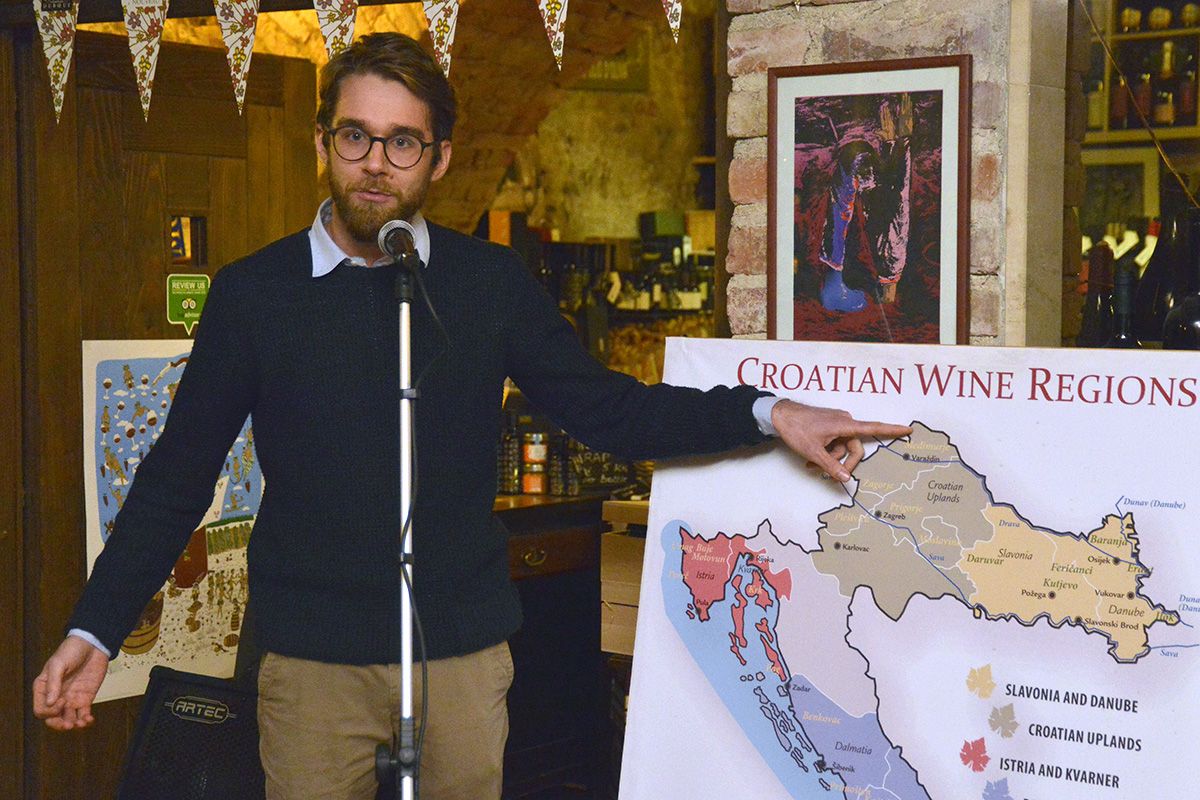
The Cmrečnjak family continues a long tradition of vineyards and winemaking. The first family cellar dates back to 1884 and today it houses the family archives. In addition to the market results, the success of Cmrečnjak family has been confirmed by the experts, since the family regularly participate in national and international competitions, winning an enviable collection of medals and awards. With an expansion of the vineyard, there has been growing demand for the Cmrečnjak quality wines. We tasted Rizvanac, harvested on 21 August 2018.
The Kocijan family cultivates vineyards located in Banfi and Orehovčak and produces excellent white wines Pušipel, Graševina, Chardonnay, Riesling, Sauvignon, Traminac Mirisavi, the Štrigovska Zvona coupage and the Cabernet Sauvignon red wine. We tasted Chardonnay, and the grapes were harvested on 3 September.
The Štampar family wines begin their lives in the vineyards, just like in the old days. They started with just 3,000 vines of one variety, with an old Croatian oak press from 1927 and barely a few dilapidated barrels in a small cellar. Today, in a constant search for the perfect combination of tradition, knowledge and innovation, the Štampars offer extremely high-quality and award-winning wines from a dozen representative varieties of the Međimurje wine area. We tasted Silvanac Zeleni, harvested on 15 September 2018.

The Kunčić family is based in Banfi, in the extreme northwest corner of Croatia. The borderline with Slovenia passes through their yard and the house, and their winery's terrace overlooks the Slovenian Pomurje region and Hungary a little further away. The cellar and the vineyards are an example of a diligent and careful approach to winemaking and continuous investment, which ultimately results in excellent wines. We tried a Cuvee of Chardonnay, Yellow Muscat and Sauvignon, with grapes harvested on 15 September.
In addition to wines, Bornstein served their famous meat plates, and the event was supported by the Oletić Butchers, with a tradition that has lasted for four decades. It is an ambitious family farm that strives to satisfy demanding customers and offers fresh meat and top-of-the-range meat products, as well as game meat and specialized meat products. Oletić has two butcher’s shops in Varaždin and Šenkovec, and a meat processing facility. With a large assortment of fresh beef, pork, veal, chicken and game meat (roe deer, boar, deer) and cured meat products processed traditionally, it supplies a number of catering facilities throughout Croatia.
The Moravec family farm – once you reach Nova Ves Petrijanečka in Varaždin County, you can follow the signs along the road and easily reach the Moravec family farm. It is a farm with 150 white goats and a dairy plant which produces various products made of goat milk, such as cheeses with colourful pepper and red pepper, spreads with pumpkin seeds and chives, and curd, while the main product is goat milk which is bottled and carries the "Milk from Croatian Farms" mark.
For more on Croatian wines, click here.

